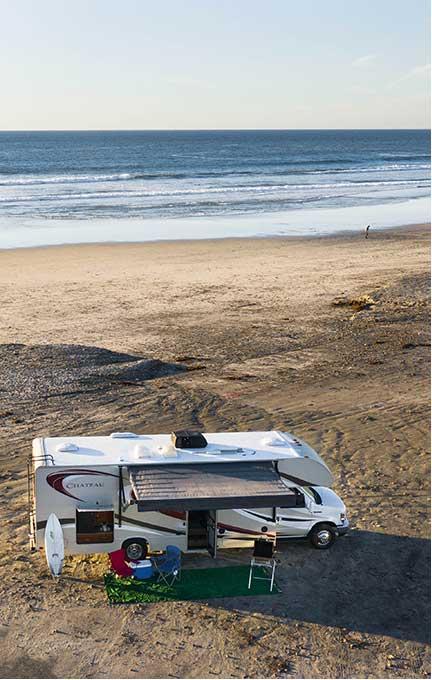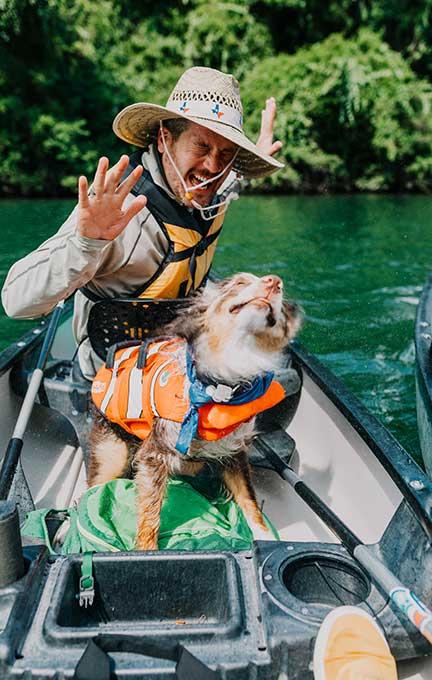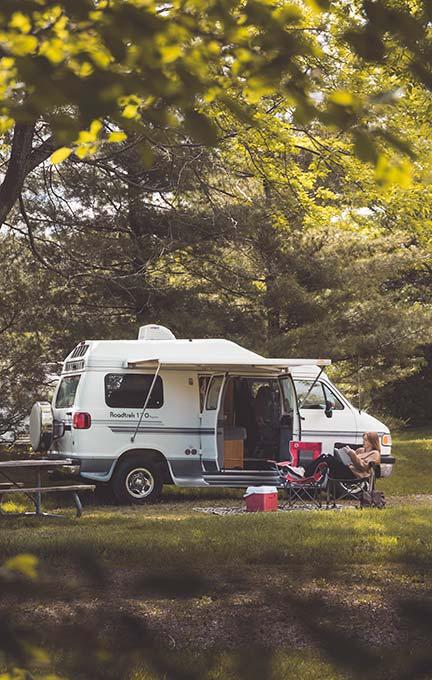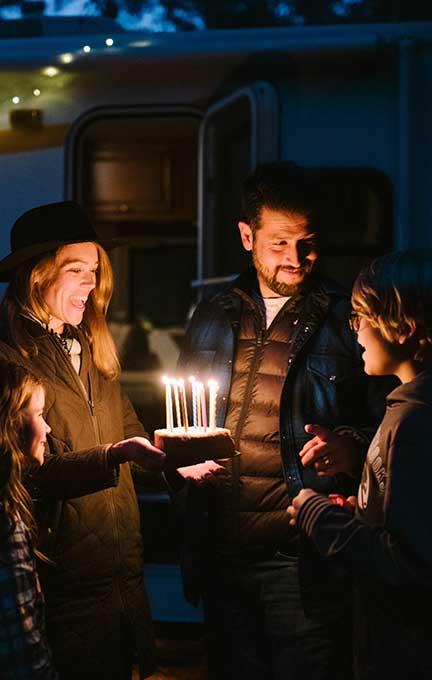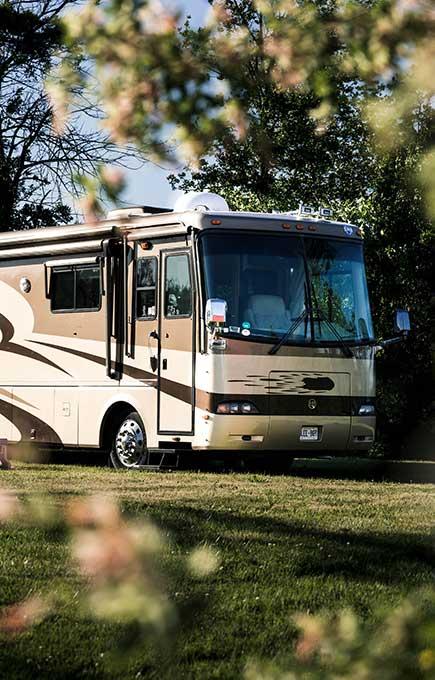It’s not a true family vacation unless everyone gets to come along— including your four-legged friends. Almost everywhere you go in an RV, you’ll find yourself surrounded by RV travelers who bring their beloved dogs or cats along for the journey. If it’s your first time bringing your pets on an RV trip, you’ve come to the right article. We’ve compiled some helpful tips about stress-free travel with Fido and how to make the most of your camping trip when you’ve got a furry pal tagging along.
Must-Have Pet Supplies When Traveling
Don’t forget to grab your pet’s travel bag when packing for your RV trip! Some of the most important things to pack include:
- Leash
- Collar w/ identifying tags
- Travel Harness
- Dog bowls
- Food
- Extra water (if dry camping)
- Treats
- Plenty of poop bags
- Toys
- Bed
- Pet first-aid kit
- Medications
- Proof of vaccinations and vet info
Think about what your pet uses on a daily basis to make sure you get everything you need. Also consider where you will be traveling to and what activities you and your pet will be participating in. For instance, if you are going to a colder climate, consider a sweater or doggie jacket. If you plan on getting out on the water, pack a life vest for your dog or cat.
Road Tripping with Pets
Going RVing with your pet is more than cuddles around the campfire. It also means having to care for them while on the road.
Video source: DoggyU
Safety First
Some pets love car rides, some don’t. If you want to take your pets camping, it’s important to make them as comfortable as possible while also keeping safety in mind. With both cats and dogs, it is important to give them their own dedicated space but also limit their ability to move around the vehicle. After all, if you were to get into an accident at 50 mph, an 80-pound dog can turn into a 2,400-pound projectile.
The two safest ways to carry a pet is to secure them with a harness that straps into the seat (basically a pet seatbelt) or place them in a crate designed for road travel. If you have a trailer, take the pets in the tow vehicle rather than the trailer. Your pets will be and feel safer if they are in the same space as you while traveling.
Keeping Your Pets Comfy
Making sure your pet is secured is most important, but don’t overlook these tips for making sure your pet is comfy and happy.
- If your pets don’t take well to motor trips, try to give them a special treat shortly after arriving at your destination. After just a couple of trips, their attitude can change dramatically as they know that treat is waiting for them at the end of it.
- Make sure your pet has access to water. If you are unable to place a stable water bowl for them in the back seat or motorhome, make sure you frequently offer them a sip.
- Pay attention to their bathroom needs. Your pet may need to go more frequently than you do. Be sure you’re on the lookout for their potty signals.
- Find local dog parks along your route. If it’s not too far out of the way, stop by a dog park once or twice a day to let your dog get some of their energy out. If you are unable to do this, make sure they get plenty of time to walk around and stretch their legs whenever you stop.
Once you get to your pet-friendly destination, it’s time for the fun part— camping and exploring!
The Campground Pet Rules
Before packing your bags, always do your research ahead of time to find out the pet rules of the places you’ll be visiting. Nothing is worse than driving hundreds of miles with your dog or cat only to be turned away because pets aren’t allowed.
Pets at Privately Owned Campgrounds
Most commercial campgrounds allow pets. Many of them even have amenities for your dogs, like designated fenced-in dog parks. The rules for pets are also pretty universal across all campgrounds.
- All pets outside the trailer must be on a leash.
- All pets outside the trailer must be accompanied by their owner at all times.
- You must clean up after your pet.
- If your pet consistently disturbs other campers, you may be asked to leave.
If you have cats that are used to going outside, then you will have to leash train them.
Although it may be tempting to let your well-behaved pets roam around your campsite, it isn’t the safest option. Even if your dog or cat obeys commands, you can’t be sure of the dangers lurking around the corner.
Pets at National Parks
National parks may be more restrictive when it comes to pets. Some national parks do not allow pets in the park while others do. It depends a lot on the sensitivity of the wildlife to domestic animals. Before you book parking at a national park or take your dog there for an adventure, be sure to check the park rules on their website. Those that do allow dogs to be walked will always require that they be on a leash at all times. It is expected you will clean up after your pooch as well.
National forests nearly always allow pets on a leash. National monuments sometimes allow pets, sometimes not depending on the type of monument it is. BLM lands almost always allow pets and even allow off-leash dogs in some cases.
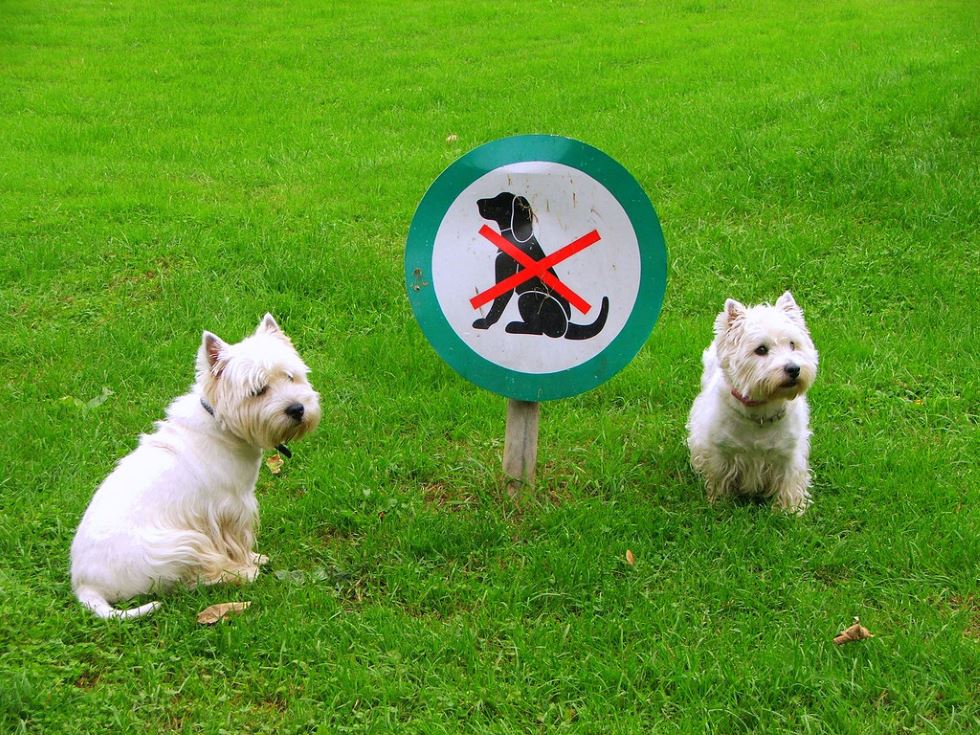
Making a Pet Feel at Home in an RV
Once you set up camp, there are few things you can do to keep your four-legged pals healthy and happy.
Create a Space for Pets
Both cats and dogs like to have a space that makes them feel secure. It can be a hiding place for cats or a nice soft bed for dogs. Whatever yours likes best, try to make a special place in your RV where your pet will feel safe and comfortable. If you can get your pet to see your pet carrier as such a place, that can be ideal. This makes it easier to transport them when needed.

Climate Control
You can’t always take your pets everywhere you might want to go. When you do need to leave them back at the trailer, it is very important that you keep their climate needs in mind. Just like a car, a trailer can get very hot or very cold very quickly if there is no climate control. If you can, leave your automatic climate control on when leaving pets in a trailer. You can also insulate and shutter windows just in case the climate control fails.
Bugs
The more traveling you do with your pet, the more likely it is that you will encounter bug issues. Each region of the country has some kind of parasite that might take a liking to your furry friends. Your first line of defense is knowledge. Read up about the pests in the regions you will travel to. Ticks are of special concern in the south and east due to Lyme disease.
Chemical protection can be a good defense, but vigilance and good grooming can also go a long way towards keeping you and your pets pest-free. Be sure to brush your pet frequently and check for fleas and ticks. Even if you treat your pet for the pest, you still may have some hitchhikers that find their way into your RV bed if you aren’t careful!

Handling Pet Emergencies While Traveling
Should an accident or illness befall your beloved pets, there is a silver lining. Nearly everywhere you go, there is likely a vet within an hour drive. Some rural areas don’t have a lot of services, but vets are needed as much in the country as in the city, so they are not typically hard to find. It is always a good practice to identify key emergency services in any area you travel to. Get the number of emergency medical services for both you and your pets and keep them handy.
Having your pet chipped is a good safety measure in case they somehow get away from you. It is going to dramatically increase the chances that you will be able to recover your pet. Remember that it doesn’t do you any good if you don’t register your pet and chip information. Your vet can tell you all the details and recommend a good chip for your pet.
Finally, you might want to consider medical insurance for your pet, especially if you are headed somewhere that has poisonous snakes or other hazards that could lead to injury. Need further convincing that pet insurance is all it’s ruffed up to be? Find pawsitively strong answers to all your questions in this post, Is Pet Insurance Worth It?
Border Crossings
Taking standard pets across state lines is never an issue, but if you want to cross into Canada or Mexico from the US, there are rules you need to take into account ahead of time. For Canada, cats need to have a certified rabies certificate ensuring they are not infected. Dogs will be inspected and should have recent vet records. For full details, see the Canadian Government guide here. Mexico is a bit more stringent and requires both a recent vet certification and proof of vaccinations. The official site is in Spanish, but PetTravel.com provides a good list of the details in English.

The Tail End
That is just about everything you need to know. Every pet is unique, some take to the life of travel naturally, others have to ease into it. The rewards of having your furry companions share your adventures are well worth the preparation needed. If you’re looking for a pet-friendly RV rental, check out Outdoorsy. Once you’ve specified your travel dates and location, you can filter your search for pets-friendly rigs by clicking “Guests” and selecting “Yes” for pets. Happy travels!




